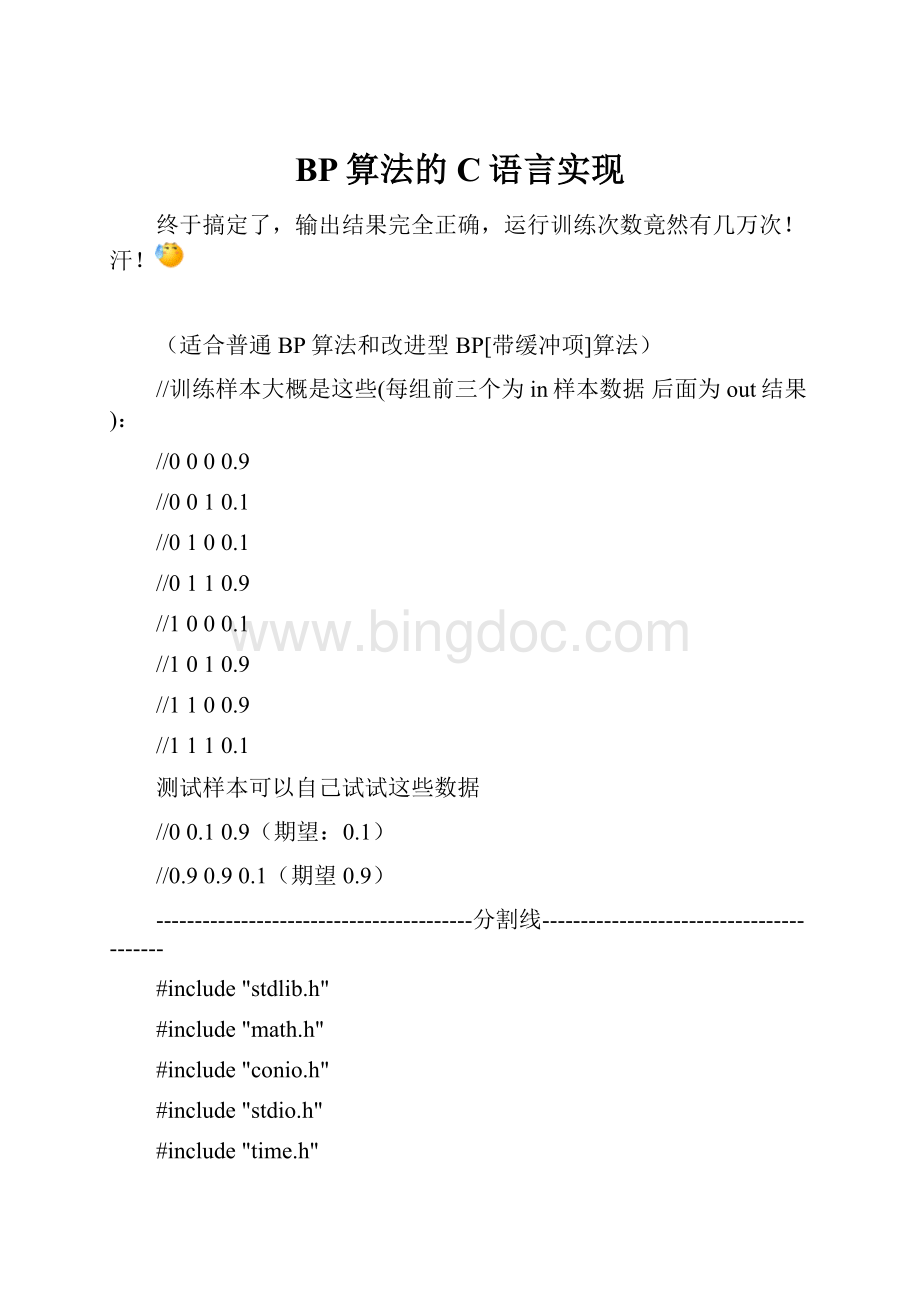BP算法的C语言实现.docx
《BP算法的C语言实现.docx》由会员分享,可在线阅读,更多相关《BP算法的C语言实现.docx(19页珍藏版)》请在冰点文库上搜索。

BP算法的C语言实现
终于搞定了,输出结果完全正确,运行训练次数竟然有几万次!
汗!
(适合普通BP算法和改进型BP[带缓冲项]算法)
//训练样本大概是这些(每组前三个为in样本数据后面为out结果):
//0000.9
//0010.1
//0100.1
//0110.9
//1000.1
//1010.9
//1100.9
//1110.1
测试样本可以自己试试这些数据
//00.10.9(期望:
0.1)
//0.90.90.1(期望0.9)
-----------------------------------------分割线-----------------------------------------
#include"stdlib.h"
#include"math.h"
#include"conio.h"
#include"stdio.h"
#include"time.h"
#defineN8/*学习样本个数(测试样本个数)*/
#defineIN3/*输入层神经元数目*/
#defineHN2/*隐层神经元数目*/
#defineON1/*输出层神经元数目*/
floatP[IN];/*单个样本输入数据*/
floatT[ON];/*单个样本教师数据*/
floatW[HN][IN];/*输入层至隐层权值*/
floatV[ON][HN];/*隐层至输出层权值*/
floatX[HN];/*隐层的输入*/
floatY[ON];/*输出层的输入*/
floatH[HN];/*隐层的输出*/
floatO[ON];/*输出层的输出*/
floatYU_HN[HN];/*隐层的阈值*/
floatYU_ON[ON];/*输出层的阈值*/
floaterr_m[N];/*第m个样本的总误差*/
floata;/*输出层至隐层学习效率*/
floatb;/*隐层至输入层学习效率*/
floatalpha; /*/动量因子,改进型bp算法使用*/
floatd_err[ON];/*δk*/
floate_err[HN];/*δj*/
FILE*fp;
/*定义一个放学习样本的结构*/
struct{
floatinput[IN];
floatteach[ON];
}Study_Data[N];
/*定义一个放测试样本的结构*/
struct{
floatinput[IN];
floatexpect[ON];
}Test_Data[N];
/*改进型bp算法用来保存每次计算的权值*/
floatold_W[HN][IN];
floatold_V[ON][HN];
intStart_Show()
{
clrscr();
printf("\n ***********************\n");
printf(" * Welcometouse *\n");
printf(" * thisprogramof *\n");
printf(" * calculatingtheBP*\n");
printf(" * model!
*\n");
printf(" * Happyeveryday!
*\n");
printf(" ***********************\n");
printf("\n\nBeforestarting,pleasereadthefollowscarefully:
\n\n");
printf(" TheprogramofBPcanstudyitselffornomorethan200000times.\nAndsurpassingthenumber,theprogramwillbeendedbyitselfin\npreventingrunninginfinitelybecauseoferror!
\n");
printf("\n\n\n");
printf("Nowpressanykeytostart...\n");
getch();
clrscr();
}
intEnd_Show()
{
printf("\n\n---------------------------------------------------\n");
printf("Theprogramhasreachedtheendsuccessfully!
\n\nPressanykeytoexit!
\n\n");
printf("\n ***********************\n");
printf(" * Thisistheend *\n");
printf(" *oftheprogramwhich*\n");
printf(" *cancalculatetheBP*\n");
printf(" * model!
*\n");
printf(" ***********************\n");
printf(" * Thanksforusing!
*\n");
printf(" * Happyeveryday!
*\n");
printf(" ***********************\n");
getch();
exit(0);
}
/*读取训练样本*/
GetTrainingData()
{inti,j,m;
floatdatr;
if((fp=fopen("sample.txt","r"))==NULL)
{
printf("Cannotopenfilestrikeanykeyexit!
");
getch();
exit
(1);
}
for(i=0;i {j=0;
while(j!
=(IN+ON)&&fscanf(fp,"%f",&datr)!
=EOF)
{if(j>IN-1)Study_Data[i].teach[j-IN]=datr;
else Study_Data[i].input[j]=datr;
/*printf("\ntheStudy_Data[%d].input[%d]=%f\n%f",i,j,Study_Data[i].input[j],datr);getch();*/
/*usetochecktheloadedtrainingdatas*/
j++;
}
}
fclose(fp);
printf("\nThereare[%d]sampledatasthathavebeenloadedsuccessfully!
\n",N*(IN+ON));
printf("\nShowthedatawhichhasbeenloadedasfollows:
\n");
for(m=0;m {for(i=0;i {printf("Study_Data[%d].input[%d]=%f ",m,i,Study_Data[m].input[i]);}
for(j=0;j {printf("Study_Data[%d].teach[%d]=%f ",m,j,Study_Data[m].teach[j]);}
}
printf("\n\n\nPressanykeytobeginStudy...");
getch();
clrscr();
return1;
}
/*初始化权、阈值子程序*/
initial()
{inti;
intii;
intj;
intjj;
intk;
intkk;
printf("\nRandsomWeightvalueandBiasvalueasfollow:
\n");
srand(time(NULL));/*随机函数种子*/
printf("\nWeightValue:
\n");
for(i=0;i for(j=0;j/*初始化输入层到隐层的权值,随机模拟0.5~-0.5*/
printf("\nw[%d][%d]=%f",i,j,W[i][j]);
}
}
for(ii=0;ii for(jj=0;jj/*初始化隐层到输出层的权值,随机模拟0.5~-0.5*/
printf("\nV[%d][%d]=%f",ii,jj,V[ii][jj]);
}
}
printf("\n\nBiasValue:
\n");
for(k=0;k YU_HN[k]=1.0;
/*隐层阈值初始化,-0.01~0.01之间*/
printf("\nYU_HN[%d]=%f",k,YU_HN[k]);
}
for(kk=0;kk YU_ON[kk]=1.0;
/*输出层阈值初始化,-0.01~0.01之间*/
printf("\nYU_ON[%d]=%f\n",kk,YU_ON[kk]);
}
printf("\n\n\n\n\nPressanykeytostartculculating...:
\n");
getch();
clrscr();
printf("Pleasewait...");
return1;
}
/*第m个学习样本输入子程序*/
input_P(intm)
{inti,j;
for(i=0;i return1;
}
/*第m个样本教师信号子程序*/
input_T(intm)
{intk;
for(k=0;kreturn1;
}
/*求净输入,输出*/
IN_OUT()
{
floatsigma1,sigma2;
inti,j,ii,jj;
for(i=0;i sigma1=0.0;
for(j=0;j {sigma1+=W[i][j]*P[j];}/*求隐层内积*/
X[i]=sigma1+YU_HN[i];
H[i]=1.0/(1.0+exp(-X[i]));
}
for(ii=0;ii sigma2=0.0;
for(jj=0;jj {sigma2+=V[ii][jj]*H[jj];}
Y[ii]=sigma2+YU_ON[ii];
O[ii]=1.0/(1.0+exp(-Y[ii]));
}
return1;
}
/*误差分析*/
/*δk*/
intErr_O_H(intm)
{intk;
floatabs_err[ON];
floatsqr_err=0.0;
for(k=0;k abs_err[k]=T[k]-O[k];
sqr_err+=(abs_err[k])*(abs_err[k]);
d_err[k]=abs_err[k]*O[k]*(1.0-O[k]);
err_m[m]=sqr_err/2;
}
return1;
}
/*δj*/
intErr_H_I()
{
intj,k;
floatsigma;
for(j=0;j sigma=0.0;
for(k=0;k {sigma+=d_err[k]*V[k][j];}
e_err[j]=sigma*H[j]*(1-H[j]);
}
return1;
}
/*总误差*/
floatErr_Sum()
{intm;
floattotal_err=0.0;
for(m=0;m {total_err+=err_m[m];}
returntotal_err;
}
/*新旧权值更新量交替--改进型Bp算法*/
saveWV()
{inti;
intii;
intj;
intjj;
for(i=0;i for(j=0;j {old_W[i][j]=b*e_err[i]*P[j];}
}
for(ii=0;ii for(jj=0;jj {old_V[ii][jj]=a*d_err[ii]*H[jj];}
}
return1;
}
/*更新权值,阈值*/
/*输出层*/
intDelta_O_H(intn,intstudy)
{intk,j;
if((n<=1)||(study=1))
{
for(k=0;k for(j=0;j {V[k][j]=V[k][j]+a*d_err[k]*H[j];}
YU_ON[k]+=a*d_err[k];
}
}
else
{
for(k=0;k for(j=0;j {V[k][j]=V[k][j]+(1.0-alpha)*a*d_err[k]*H[j]+alpha*old_V[k][j];}
YU_ON[k]+=a*d_err[k];
}
}
return1;
}
/*隐层*/
Delta_H_I(intn,intstudy)
{inti,j;
if((n<=1)||(study=1))
{
for(j=0;j for(i=0;i {W[j][i]=W[j][i]+b*e_err[j]*P[i];}
YU_HN[j]+=b*e_err[j];
}
}
else
{
for(j=0;j for(i=0;i {W[j][i]=W[j][i]+(1.0-alpha)*b*e_err[j]*P[i]+alpha*old_W[j][i];}
YU_HN[j]+=b*e_err[j];
}
}
return1;
}
/*保存更新*/
voidsavequan()
{inti,j,k;
intii,jj,kk;
/*saveweight*/
if((fp=fopen("weight.txt","a"))==NULL)
{
printf("Cannotopenfilestrikeanykeyexit!
");
getch();
exit
(1);
}
for(i=0;i {for(j=0;j fprintf(fp,"\n");
for(ii=0;ii {for(jj=0;jj fclose(fp);
printf("\nTheresultofweight.txt(quanzhi)hasbeensavedsuccessfully!
");
/*savelimit*/
if((fp=fopen("limit.txt","a"))==NULL)
{
printf("Cannotopenfilestrikeanykeyexit!
");
getch();
exit
(1);
}
for(k=0;k for(kk=0;kk fclose(fp);
printf("\nTheresultoflimit.txt(yuzhi)hasbeensavedsuccessfully!
\n\n\n\n\nPressanykeytoTest...");
getch();
clrscr();
}
/*读取测试样本*/
GetTestData()
{inti,j,m;
floatdatr;
if((fp=fopen("test.txt","r"))==NULL)
{
printf("Cannotopenfilestrikeanykeyexit!
");
getch();
exit
(1);
}
for(i=0;i {j=0;
while(j!
=(IN+ON)&&fscanf(fp,"%f",&datr)!
=EOF)
{if(j>IN-1)Test_Data[i].expect[j-IN]=datr;
else Test_Data[i].input[j]=datr;
j++;
}
}
fclose(fp);
printf("\nThereare[%d]testdatasthathavebeenloadedsuccessfully!
\n",N*(IN+ON));
printf("\nShowthedatawhichhasbeenloadedasfollows:
\n");
for(m=0;m {for(i=0;i {printf("Test__Data[%d].input[%d]=%f ",m,i,Test_Data[m].input[i]);}
for(j=0;j {printf("Test__Data[%d].expec[%d]=%f ",m,j,Test_Data[m].expect[j]);}
}
printf("\n\n\n\nPressanykeytoculculating...");
getch();
clrscr();
return1;
}
/*样本测试及结果*/
Test()
{inti,j,k,m;
floatnet1[HN],net2[ON],H_net[HN],O_net[ON];
for(m=0;m {for(i=0;i {net1[i]=0.0;
for(j=0;j {net1[i]+=Test_Data[m].input[j]*W[i][j];
}
net1[i]=net1[i]+YU_HN[i];
H_net[i]=1.0/(1.0+exp(-net1[i]));
}
for(k=0;k {net2[k]=0.0;
for(j=0;j {net2[k]+=H_net[j]*V[k][j];
}
net2[k]=net2[k]+YU_ON[k];
O_net[k]=1.0/(1.0+exp(-net2[k]));
printf("\nTestresult[%d]=%f\n",m,O_net[k]);
}
}
}
/*直接输入测试*/
OnlineSet()
{chars;
printf("\n\n\n\nIfyouwanttotestthedatayouinputtednow,pressY(orotherbuttonexceptQ);\nOrpressQtoquitTest!
\n");
while
(1){
s=getch();
switch(s)